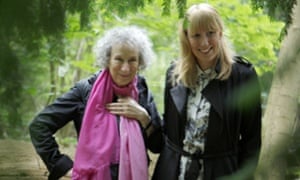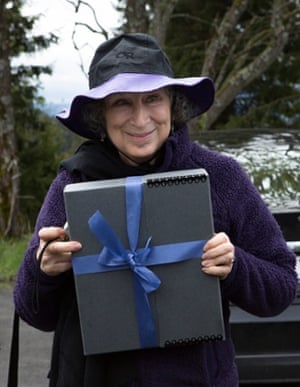Into the woods: Margaret Atwood reveals her Future Library book, Scribbler Moon
We follow Atwood through a wet forest in Norway as she hands over the manuscript for a book that won’t be read for 100 years. Plus: David Mitchell is named as the project’s next writer

Margaret Atwood and artist Katie Paterson in Oslo’s Nordmarka forest.
Sodden with rain and standing amid the calf-high shoots of 1,000 newly planted pine trees in Oslo’s Nordmarka forest, Margaret Atwood is revealing the title of her latest work. “It’s Scribbler Moon,” she says. “And that’s the only part of it you will know for 100 years.”
The Booker prize-winning Canadian novelist is here to deliver the manuscript she has worked on in total secrecy over the past year. The young trees surrounding her will grow to make the paper her work will be printed on in a century’s time. Over the next 100 years, 99 more authors – one a year – will contribute a text to the Future Library, as Scottish conceptual artist Katie Paterson has called her project. Britain’s David Mitchell has just been announced as 2015’s writer. In 2114, the 1,000 trees planted last summer in the Nordmarka will be cut down and all the texts made public.
“There’s something magical about it,” says Atwood. “It’s like Sleeping Beauty. The texts are going to slumber for 100 years and then they’ll wake up, come to life again. It’s a fairytale length of time. She slept for 100 years.”

The Booker prize-winning Canadian novelist is here to deliver the manuscript she has worked on in total secrecy over the past year. The young trees surrounding her will grow to make the paper her work will be printed on in a century’s time. Over the next 100 years, 99 more authors – one a year – will contribute a text to the Future Library, as Scottish conceptual artist Katie Paterson has called her project. Britain’s David Mitchell has just been announced as 2015’s writer. In 2114, the 1,000 trees planted last summer in the Nordmarka will be cut down and all the texts made public.
“There’s something magical about it,” says Atwood. “It’s like Sleeping Beauty. The texts are going to slumber for 100 years and then they’ll wake up, come to life again. It’s a fairytale length of time. She slept for 100 years.”

Margaret Atwood holding the manuscript for Scribbler Moon, which no one will read until 2114. Photograph: Kristin von Hirsch
Following sawdust arrows laid on the forest pathways, walking past wood anemones and blueberry bushes, streams and moss, Atwood and a straggling crowd had made their way from the train station high above the Oslo fjord to the site where the handover ceremony took place.
“I am sending a manuscript into time,” notes the author, in a short piece written for the event. “Will any human beings be waiting there to receive it? Will there be a ‘Norway’? Will there be a ‘forest’? Will there be a ‘library’? How strange it is to think of my own voice – silent by then for a long time – suddenly being awakened, after 100 years. What is the first thing that voice will say as a not-yet-embodied hand draws it out of its container and opens it to the first page? I picture this encounter – between my text and the so-far nonexistent reader – as being a little like the red-painted handprint I once saw on the wall of a Mexican cave that had been sealed for over three centuries. Who now can decipher its exact meaning? But its general meaning was universal: any human being could read it. It said: ‘Greetings. I was here.’”
Later, speaking in the Oslo library that will eventually house, in a wood-lined room, the sealed manuscripts, Atwood says she had been given three rules by Paterson: “I can’t say what’s in the box and I can’t just put a photo album in. But it could be any length, one word or 1,000 pages, a story, a novel, poems, non-fiction.”
The intention is to print 3,000 copies of all of the texts once the collection is completed; 1,000 certificates, entitling their bearer to an edition come 2114, are available now. Almost 100 have already been sold at £600 apiece. “We really don’t know who’ll be reading it,” Atwood says. “We’re also dealing with the morphing of language over time. Which words that we use today will be different, archaic, obsolete? Which new words will have entered the language? We don’t know what footnotes we will need. Will they have computers? Will they call them something else? What will they think smartphones are? Will that word still exist?”
It’s the same quandary experienced by Winston Smith in Nineteen Eighty-Four, she says, when he begins writing his journal. “How could you communicate with the future?” wrote George Orwell. “It was, of its nature, impossible. Either the future would resemble the present, in which case it would not listen to him, or it would be different from it, and his predicament would be meaningless.”
But the very concept of Future Library, which will be sustained by a trust, contains a kernel of hope: that there will be people around in 100 years, that they will be reading, that they will be listening. Mitchell – whose latest novel The Bone Clocks deals, like Atwood has, with a dystopian future and the concept of time – calls it “a vote of confidence that, despite the catastrophist shadows under which we live, the future will still be a brightish place willing and able to complete an artistic endeavour begun by long-dead people a century ago”.
He adds: “Imagine if the Future Library had been conceived in 1914 and 100 authors from all over the world had written 100 volumes between then and today, unseen until now. What a human highway through time to be a part of. Contributing and belonging to a narrative arc longer than your own lifespan is good for your soul.”

How the wood-lined Future Library will look. Illustration: Atelier Oslo and Lund Hagem
Paterson’s previous projects have included burying a nano-sized grain of sand deep within the Sahara desert and broadcasting the sounds of a melting glacier live to someone in an art gallery, via their mobile phone. How did she come up with this idea? “I saw a connection between tree rings, paper, pulp and future writers,” she says. “We wouldn’t have done this if we didn’t believe in future people to cut the trees and make the book. Books are probably going to go through a multitude of changes we can’t even imagine, whether digital or something completely different. But Umberto Eco compared it to the wheel. He said, ‘How can it ever get better?’ So I’m sure it will be around. But this is our small way of preserving the printed book.”
Atwood agrees. “If we save the oceans then, yes, endemic plagues aside, there will be a human race.”
Future authors will come from all around the world, says Paterson, who knew from the outset that her project would outlive her. “I knew I would be dead,” she says. “But it’s weird to think that I will be hobbling up to these trees when I’m 90-something. It doesn’t matter if I’m there or not, though. The rituals will keep going. Time stands still in the forest.”
Margaret Atwood will be in conversation with British novelist Naomi Alderman at a Guardian Live event on 29 September.
From: The Guardian
No comments:
Post a Comment